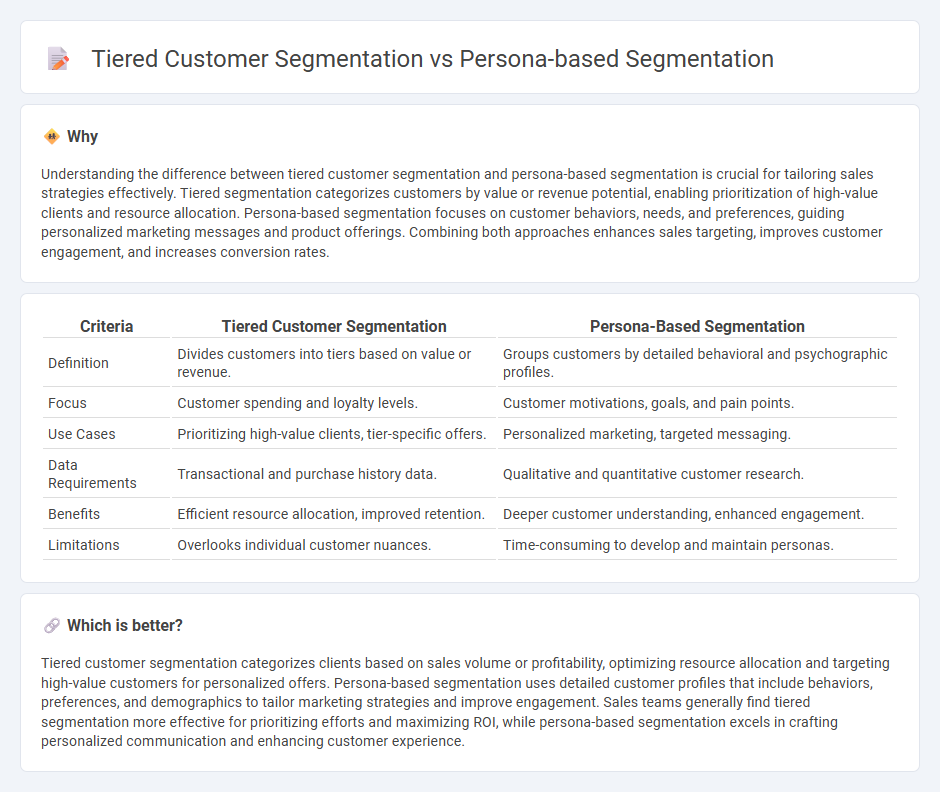
Tiered customer segmentation categorizes buyers based on quantifiable criteria such as purchase frequency and spending levels, enabling sales teams to tailor strategies for high-value clients and optimize resource allocation. Persona-based segmentation delves into behavioral traits, motivations, and challenges, creating detailed customer profiles that drive personalized messaging and product positioning. Explore how combining these segmentation approaches can enhance targeting precision and boost sales effectiveness.
Why it is important
Understanding the difference between tiered customer segmentation and persona-based segmentation is crucial for tailoring sales strategies effectively. Tiered segmentation categorizes customers by value or revenue potential, enabling prioritization of high-value clients and resource allocation. Persona-based segmentation focuses on customer behaviors, needs, and preferences, guiding personalized marketing messages and product offerings. Combining both approaches enhances sales targeting, improves customer engagement, and increases conversion rates.
Comparison Table
| Criteria | Tiered Customer Segmentation | Persona-Based Segmentation |
|---|---|---|
| Definition | Divides customers into tiers based on value or revenue. | Groups customers by detailed behavioral and psychographic profiles. |
| Focus | Customer spending and loyalty levels. | Customer motivations, goals, and pain points. |
| Use Cases | Prioritizing high-value clients, tier-specific offers. | Personalized marketing, targeted messaging. |
| Data Requirements | Transactional and purchase history data. | Qualitative and quantitative customer research. |
| Benefits | Efficient resource allocation, improved retention. | Deeper customer understanding, enhanced engagement. |
| Limitations | Overlooks individual customer nuances. | Time-consuming to develop and maintain personas. |
Which is better?
Tiered customer segmentation categorizes clients based on sales volume or profitability, optimizing resource allocation and targeting high-value customers for personalized offers. Persona-based segmentation uses detailed customer profiles that include behaviors, preferences, and demographics to tailor marketing strategies and improve engagement. Sales teams generally find tiered segmentation more effective for prioritizing efforts and maximizing ROI, while persona-based segmentation excels in crafting personalized communication and enhancing customer experience.
Connection
Tiered customer segmentation categorizes buyers based on their value or engagement level, facilitating targeted marketing efforts. Persona-based segmentation complements this by creating detailed profiles that capture behavioral and demographic traits within each tier. Combining both approaches enhances precision in sales strategies, driving higher conversion and customer retention rates.
Key Terms
Buyer Persona
Persona-based segmentation centers on detailed Buyer Personas, which represent specific customer archetypes defined by behavioral traits, goals, and challenges, enabling highly personalized marketing strategies. Tiered customer segmentation classifies customers into hierarchical levels based on metrics like purchase frequency or spending, often overlooking the nuanced motivations captured by Buyer Personas. Explore the advantages of integrating Buyer Personas into segmentation to enhance customer targeting and engagement strategies.
Demographic Segmentation
Demographic segmentation classifies customers based on quantifiable traits such as age, gender, income, and education, crucial for both persona-based and tiered customer segmentation models. Persona-based segmentation builds detailed profiles representing key customer types, integrating demographic data to tailor marketing strategies effectively. Explore how focusing on demographic criteria enhances segmentation accuracy and marketing ROI by diving deeper into these methodologies.
Account Tiering
Persona-based segmentation categorizes customers by demographic, psychographic, and behavioral traits to tailor marketing strategies, whereas tiered customer segmentation, especially account tiering, ranks customers based on their value, revenue potential, and strategic importance. Account tiering prioritizes resource allocation and sales efforts by grouping customers into tiers such as platinum, gold, and silver, optimizing engagement and retention. Explore deeper insights into how account tiering enhances customer management and drives business growth.
Source and External Links
What Is Persona Segmentation in Marketing and Why Is It Important? - Persona-based segmentation identifies and groups people into personas based on common traits such as demographics, behavior, and preferred communication channels, helping businesses tailor marketing messages and choose effective channels for each persona.
Segment vs Persona: What's the Difference & How To Create Both - Persona segmentation creates fictional yet detailed profiles representing ideal customers with specific goals and motivations, while segments are broader groups defined by shared characteristics, enabling targeted marketing and user engagement strategies.
Segments vs. Personas - OHO - Persona segmentation involves building highly detailed, specific profiles of individual customers that guide personalized content, whereas segmentation groups customers more broadly for broader strategic targeting.
 dowidth.com
dowidth.com